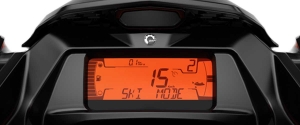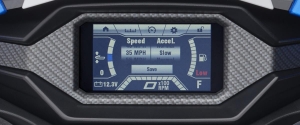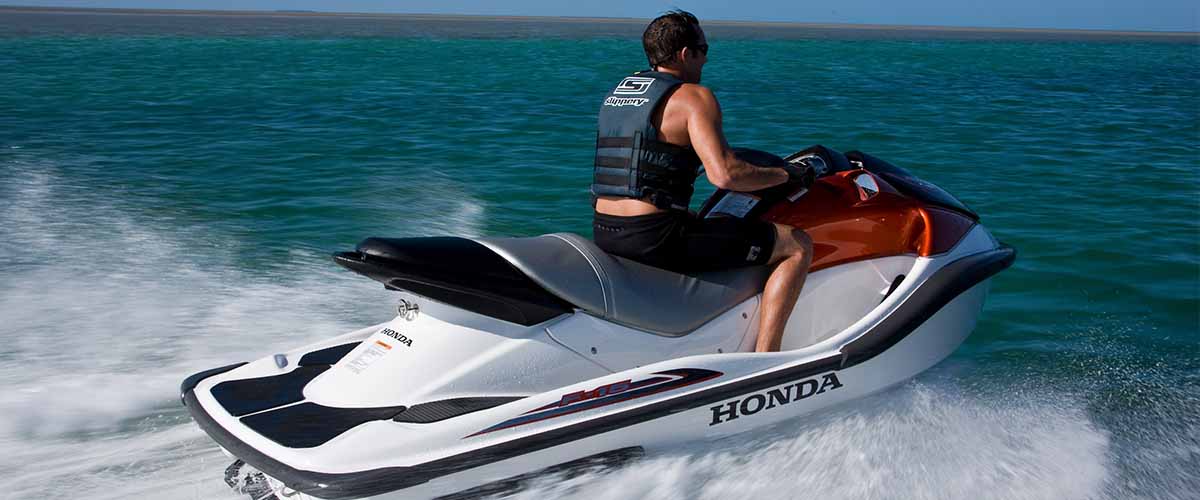Kawasaki Jet Ski Fault Code List [Chart]
Even if you properly maintain your Jet Ski, problems can still occur.
If your jet ski won’t start or has other issues, you can try to troubleshoot the problem yourself. As a first step, you will have to read the fault codes to learn more about the malfunction.
For your convenience, we at JetDrift have compiled the official Kawasaki Jet Ski fault codes into this post!
Kawasaki Jet Ski Fault Code List
Without further ado, please find the official Kawasaki jet ski fault codes in one chart. (These codes are often referred to as trouble codes or diagnostic codes.)
Official Kawasaki Jet Ski Fault Code Chart
| Service Code (Use in ECU) | Service Code Character | Possible Problem | Fail-Safe Function |
|---|---|---|---|
| 11 | tP5 | Throttle sensor malfunction, wiring open or short | If both throttle position sensor 1 and2 fail, the ECU sets the DFI in the D-J method (see Note 1) and sets to the limp mode (see Note 2). If either sensor fails, the ECU sets to the power limitation mode (see Note 3). |
| 12 | h05t | Inlet air pressure sensor malfunction, wiring open or short | The ECU sets the DFI in the α-N method (see Note 4) |
| 13 | Rht | Inlet air temperature sensor malfunction, wiring open or short | The ECU sets the inlet air temperature at 40° |
| 14 | RQUt | Water temperature sensor malfunction, wiring open or short | The ECU sets the water temperature at 70°C. The ECU slows down the engine speed less than 3 000 r/min(rpm) by controlling the ignition (Engine activates Slow Down Mode). |
| 18 | APS | Accelerator position sensor malfunction, wiring open or short. | If both accelerator position sensor 1and 2 fail, the ECU sets to the idle mode (see Note 5). If either sensor fails, the ECU sets to the power limitation mode (see Note 3). |
| 21 | CrR9 | Crankshaft sensor malfunction, wiring open or short | The engine stops by itself. |
| 23 | CrR1 | Cam shaft position sensor malfunction, wiring open or short | The ECU continues to ignite cylinders in the same sequence following the last good signal |
| 24 | SP5E | Speed sensor malfunction, wiring open or short. | The speedometer shows 0. |
| 31 | d05 | Vehicle - down sensor malfunction, wiring open or short | The ECU slows down the engine speed less than 3 000 r/min (rpm) by controlling the ignition. |
| 35 | Innb | Immobilizer amplifier malfunction. | - |
| 36 | I9n1 | Blank key detection. | - |
| 45 | F-P1 | Fuel pump relay malfunction, wiring open | - |
| 46 | F-P2 | Fuel pump relay malfunction, relay is stuck | - |
| 49 | SPr1 | Return spring malfunction. | - |
| 51 | COL1 | Ignition coil #1, #4 malfunction, wiring open or short | The ECU shuts off the injectors #1/#4to stop fuel to the cylinders #1/#4. |
| 52 | COL2 | Ignition coil #2, #3 malfunction, wiring open or short | The ECU shuts off the injectors #2/#3to stop fuel to the cylinders #2/#3. |
| 57 | rEL2 | System relay malfunction, relay is stuck. | - |
| 58 | Et1 | ETV actuator malfunction, wiring open or short. | If the ETV actuator fails (the signal is out to the usable range, wiring short or open), the ECU stops the current to the actuator, and sets to the limp home mode (see Note 2). |
| 71 | HEAt | Engine overheat | The ECU slows down the engine speed less than 3 000 r/min (rpm) by controlling the ignition. |
| 72 | OILP | Engine oil pressure too low | The ECU slows down the engine speed less than 3 000 r/min (rpm) by controlling the ignition. |
| 73 | Oilt | Oil temperature sensor malfunction, wiring open or short | The ECU sets the oil temperature at 60°C.The ECU slows down the engine speed less than 3 000 r/min (rpm) by controlling the ignition. |
| 75 | rEL | ECU main relay malfunction, wiring is open or relay is stuck. | - |
| 76 | OILH | Engine oil overheat | The ECU slows down the engine speed less than 3 000 r/min (rpm) by controlling the ignition. |
| 77 | Po5I | Electric trim control sensor malfunction, wiring open or short. | The ECU sets the electric trim at top position. |
| 97 | bAt2 | Battery monitor voltage is low. | The ECU sets to the limp home mode (see Note 2). |
| 98 | Cont | ECU/ETV circuit malfunction, wiring open or short. | The ECU sets to the limp home mode(see Note 2). |
“Note:
(1): D-J Method: When the engine load is light like at idling or low speed, the ECU determines the injection quantity by calculating from the throttle vacuum (intake air pressure sensor output voltage) and engine speed (crankshaft sensor output voltage).
(2): Limp Home Mode: ETV is not operational. Power is controlled by ignition timing.
(3): Power Limitation Mode: ETV is in operational condition by redundant system.
(4): α-N Method: As the engine speed increases, and the engine load turns middle to heavy, the ECU determines the injection quantity by calculating from the throttle opening (throttle position sensor output voltage) and the engine speed.
(5): Idle Mode: ECU sets the engine speed at the idle speed.”
Source: Kawasaki.com
Disclaimer: This chart is only for informational purposes! Although these codes are valid for most modern fuel-injected Kawasaki jet skis, the codes may vary depending on the model. For more accurate information, make sure you refer to your jet ski’s owner’s or service manual.
How to Read Kawasaki Jet Ski Fault Codes
How can you read the fault codes on a jet ski? – this is a common question of many beginner riders.
Fortunately, modern Kawasaki jet skis are equipped with a large screen on which the fault codes are displayed. According to the manufacturer, the official process for reading the service codes on a Jet Ski is as follows:
“Service Code Character Reading
- The service code character(s) is displayed on the LCD.
- When there are problems, all the service code characters can be stored, and the display will begin starting from the lowest number of service code character.
- Then after completing all codes, the display is repeated until the ignition switch is turned OFF or either “SET” or “MODE” button is pushed for more than one second.
- For example, if three problems occurred in the order of 51, 13, 31, the service code characters are displayed (each one second) from the lowest number service code character in the order listed as shown below.13 (Alrt) → 31 (dOS) → 51 (COL1) → 13 (Alrt) → 31 (dOS) → 51 (COL1) →· · ·(repeated) FI Trouble [A]Immobilizer Trouble [B]
- If there is no problem or when the repair has been done, FI and/or immobilizer warning indicators go off and “FI” character and/or service code character is not displayed.”
Source: Kawasaki.com
Reading Jet Ski Fault Code with CanDooPro
The service codes displayed on the dashboard will only give you a brief description of the malfunction. If you want to dig into the details to accurately diagnose the issue, you may want to use a jet ski diagnostic tool.
It’s safe to say that one of the most popular diagnostic tools is the CanDooPro. As the name suggests, this product was originally developed for Sea-Doos, but has also been supporting all fuel-injected Kawasaki Jet Skis since 2012!
CanDooPro helps you accurately diagnose the problem with your jet ski and fix it. The main advantage of this product is that it costs a fraction of the price of the factory PWC diagnostic tool.
What’s in the box?
In a nutshell, the key elements of the CanDooPro tool are as follows:
- CANDooPro Diagnotic Box
- Kawasaki Diagnostic Cables
- USB Cable
- Software Download
If you have other brands of jet skis or powersport vehicles, the good news is that CanDooPro supports Sea-Doos, WaveRunners, and various brands of ATVs, UTVs, and snowmobiles. On the other hand, keep in mind that different machines require different diagnostic cables for proper connections.
CanDooPro Minimum System Requirements
- 2 Ghz or Faster Processor
- 2 GB Ram
- 800×600 Resolution
- USB ver2.0
- .NET 3.5 SP1
- Windows 8, 10, 11
- Internet Connection (for updates and installation)
The key features of the CanDooPro system are as follows:
- Program Keys / Lanyards (Learning, Rental, Normal)
- Change Owner Information and Purchase Date
- Reset TPS to zero position
- Read Fault Codes along with fault data, and reset faults
- Reset Maintenance Light
- Reset Supercharger Light
- Reset Service Hours
- Reset Service Rental Hours
- Set Ignition Correction and Curves (2-stroke only)
- Real Time Engine Monitor
- Marry Clusters to ECU’s
- Last 30 or 60 Sec history
- Activate fuel pump, Spark Plugs, Buzzer, etc.
- Key Tester
How to Clear Fault Codes on a Kawasaki Jet Ski
Once you’ve repaired the malfunction, you probably want to know how to erase the fault code on your Jet Ski. The good news is that once you’ve eliminated the issue, the service code should automatically disappear.
According to the manufacturer:
- “When repair has been done, FI and/or immobilizer warning indicators go off and “FI” character and/or service code character is not displayed. But the service code characters stored in memory of the ECU are not erased to preserve the problem history.
- On certain models, the problem history can not be erased. However, the past service code characters can be erased using the KDS 3 version kit.”
Conclusion
Modern Kawasaki Jet Skis display the fault codes on their LCD display. Unfortunately, these codes only provide a general description of the problem. If you want to find out more about the malfunction, it’s recommended that you attach a diagnostic tool to your ski.
This is where CanDooPro comes into play because it can be used to carefully investigate the issue. Fortunately, this product has been supporting Kawasaki Jet Skis since 2012.
It offers an easy and convenient way for you to read the fault codes on your Jet Ski yourself.
If you don’t want to invest in his tool, your other option is to take your craft to an authorized Kawasaki dealership.
If you are not mechanically inclined, the latter is probably the best option because even if you can read the fault code at home, you will likely have to take the craft to a mechanic for repairs!
DISCOVER 2024 PWC MODELS Kawasaki, Sea-Doo, Yamaha, Krash…








